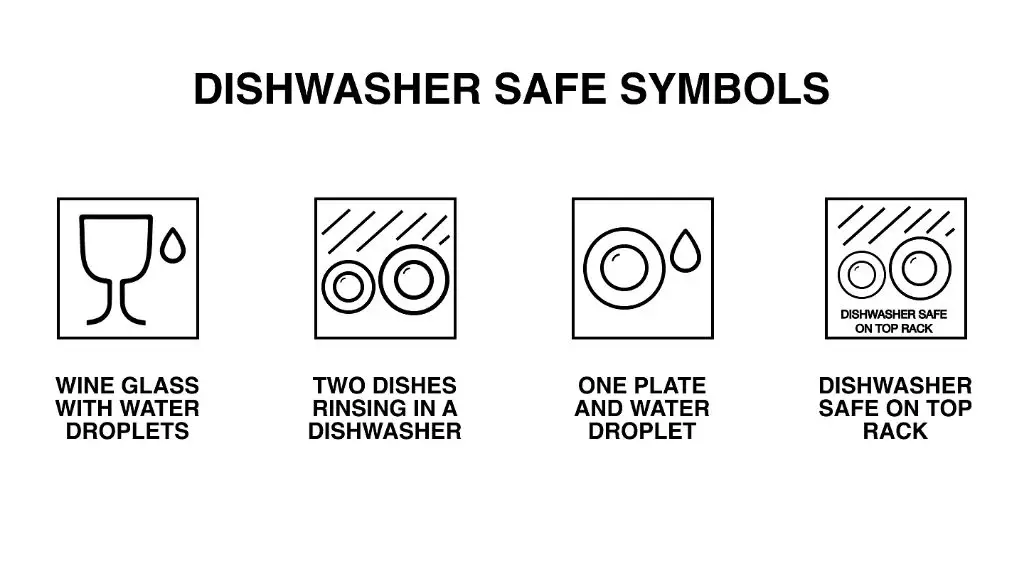Does The Glass And Fork Symbol Mean Dishwasher Safe?
The glass and fork symbol is commonly seen on dishes, cookware, and other kitchen items. It is a symbol that indicates whether an item is safe to use in the dishwasher. This article will provide a brief history of the symbol, explain what the symbol means, discuss the types of materials that can have this symbol, look at safe temperatures for items with the symbol, review proper cleaning methods, cover any exceptions, and clarify other similar symbols. There are some common misconceptions about what the glass and fork truly signifies that will also be addressed.
History of the Glass and Fork Symbol
The glass and fork symbol has been used for decades to indicate if an item is safe to wash in the dishwasher. It’s unclear exactly when it first started appearing on dishware and cutlery, but it became common starting in the 1950s and 1960s as dishwashers began entering more households.
At that time, most dishware was made from porcelain, glass, stainless steel or melamine – all materials recognized as durable enough to withstand high heat and harsh dishwasher detergents. The symbol provided an easy way for manufacturers to communicate to consumers that their products were dishwasher-safe.
Since many dishes before the rise of dishwashers were hand-washed, the glass and fork image offered a quick visual shorthand. It assured buyers that the dishware they were purchasing was specially designed and tested to allow machine washing without damage.
While the origins are hazy, the symbol clearly developed in conjunction with the increasing popularity and availability of household dishwashing machines. Over decades it has become a ubiquitous sight for consumers choosing dishware confident it will emerge unharmed from the dishwasher.
Meaning
The glass and fork symbol is commonly used to indicate that an item is dishwasher safe. The glass represents dishware like plates, bowls, cups, etc. while the fork represents cutlery like knives, forks, and spoons. Together, the image of the glass and fork conveys that the item can be safely cleaned in a dishwasher without damage.
While there is no universally standardized symbol, the glass and fork has become widely recognized and understood to mean dishwasher safe. When used on an item like a plate or utensil, it provides a quick visual indication that the item can withstand high dishwasher temperatures, forceful spray, and dishwasher detergents without warping, fading, or corroding. This allows consumers to easily identify dishwasher safe items when making purchases.
Some variations on the glass and fork symbol may include additional items like spoons or plates. However, the core glass and fork imagery clearly communicates dishwasher safe to most consumers. The symbol is commonly found on dishes, glasses, utensils, cookware, and various other kitchen items.
Materials
The glass and fork symbol is commonly found on materials that are considered food safe, meaning they can safely come into contact with food and drinks without leaching harmful chemicals. This includes items like glassware, plates, bowls, cups, and utensils made from materials such as glass, stainless steel, ceramic, and certain types of food-grade plastic.
Glass and ceramic materials are naturally inert and do not react with foods, so they are widely used for dishes and cookware. Stainless steel contains metals like chromium and nickel that prevent corrosion and leaching. Food-grade plastics like polyethylene, polypropylene, and polycarbonate are engineered to be non-porous and stable at typical food service temperatures.
The glass and fork symbol provides assurance that items bearing the symbol have been verified as safe for direct food contact. It indicates the items do not contain lead, cadmium or other toxic metals that could leach into foods. The symbol is commonly stamped or molded onto the bottom of plates, bowls, cups and other serving dishes or utensils.

Safe Temperatures
The fork and glass symbol indicates that an item is safe to use in dishwashers that reach certain high temperatures during cleaning cycles. Most dishwashers operate with internal temperatures between 140-150°F on normal wash cycles and 160-165°F on heavy or sanitizing cycles 1. Items marked as dishwasher safe with the fork and glass symbol are engineered to withstand exposure to these common dishwasher temperatures without warping or breaking down.
For example, according to Buffet Plus, their polycarbonate products with the symbol are rated for temperatures up to approximately +100°C or 212°F 1. This means they can safely withstand the high heat inside a dishwasher on any cycle. On the other hand, their GN dishes are stated as safe up to 165°F 2, making them suitable for normal and heavy wash cycles but not necessarily the highest heat sanitizing setting.
In summary, the fork and glass symbol verifies that an item has passed testing to confirm it can safely handle dishwasher temperatures up to at least 140°F for regular cycles, and around 165°F for sanitizing modes, without deteriorating or breaking.
Cleaning
The dishwasher safe symbol indicates that an item can withstand the high water temperatures and strong detergents used in automatic dishwashers. According to How to Choose Kitchenware: A Comprehensive Guide, items marked as dishwasher-safe will save time by allowing them to be cleaned along with other dishes in the dishwasher rather than requiring delicate handwashing.
The symbol gives consumers confidence that the item will not be damaged by the dishwasher cleaning process. As explained on the product page for the TEFAL Cook & Clean 20cm Non Stick Deep Frypan, the pan is advertised as “dishwasher safe” meaning it can withstand the high heat and detergents without being damaged.
Exceptions
While the dishwasher safe symbol generally indicates an item can safely be cleaned in the dishwasher, there are some exceptions to be aware of:
Plastic items marked as dishwasher safe may still degrade over time with repeated dishwasher use. Thin or cheaper plastic in particular can become brittle and degrade more quickly, even if marked as dishwasher safe. It’s generally best to avoid putting plastic in the dishwasher whenever possible and instead hand wash (Source: Reddit).
Wooden items like cutting boards and utensils should never go in the dishwasher, even if marked as dishwasher safe. The high heat and harsh detergents can damage the wood over time (Source: The Spruce).
Cast iron cookware should not be washed in the dishwasher as it can rust and degrade the seasoning. Hand washing is best for cast iron (Source: The Spruce).
Other Symbols
The glass and fork symbol is the most common symbol used to indicate whether an item is dishwasher safe. However, there are some other symbols that may also appear on dishware and cutlery:
The cup and fork symbol is very similar to the glass and fork, with the only difference being the cup shape instead of a glass. Like the glass and fork, the cup and fork indicates an item is safe to clean in the dishwasher.
Some manufacturers use a simple fork or knife symbol, often inside a circle, to denote dishwasher safety. This is a more simplified version of the glass/cup and fork image.
A wine glass symbol may be used for items intended for formal dining like crystal stemware. This signifies dishwasher safe while acknowledging the delicate nature of the item.
In contrast to these positive symbols indicating dishwasher safety, a crossed out circle is used to specify when an item is not dishwasher safe and should be hand washed only.
While there are some variations, the classic glass and fork remains the most common and recognizable symbol used to designate dishwasher safe dishware, utensils and cookware. It is easily distinguished from negative or hand wash only symbols.
Misconceptions
There are a few common misconceptions about the meaning of the glass and fork symbol. Some people believe that the symbol means something is microwave safe, when in reality it has nothing to do with microwaves. According to the website Do you Know Your Tableware Symbols?, the symbol simply indicates that the material is safe for food use.
Another misconception is that the glass and fork symbol guarantees something is dishwasher safe. While many items with this marking can be cleaned in the dishwasher, it does not necessarily mean an item is 100% dishwasher proof. The symbol is more so stating that the material is approved for food contact. Certain materials like hand-painted glass may have the symbol but are not intended for the high heat and harsh detergents of a dishwasher.
There is also confusion between this symbol and other common marks found on tableware like cups, plates, and utensils. For example, some people mix up the meaning of the glass and fork symbol with the microwave safe symbol of the cup and wave image. According to the website Common Misconceptions about the Michelin Guide, it’s important to understand the distinctions between these food safety symbols and their meanings.
Conclusion
In summary, the glass and fork symbol is commonly used to indicate that an item is dishwasher safe. The symbol features the image of a drinking glass and fork, implying that the item can be safely cleaned in a dishwasher without damage.
The key takeaway is that the glass and fork symbol unambiguously signifies dishwasher-safe. When you see this symbol on plates, cups, utensils and other items, you can confidently wash them in the dishwasher without worry.
While certain materials like hand-painted china may still require hand washing, the glass and fork symbol generally means an item is sturdy enough to withstand high dishwasher temperatures, detergents and the force of spray jets. By following best practices like not overloading or improperly stacking items, you can maximize the cleaning power and convenience of your dishwasher.
So next time you see the ubiquitous glass and fork, remember it’s reassuring you that the item can be safely cleaned by your trusty dishwasher. This simple symbol has become a promise of an easier, less laborious washing experience.



